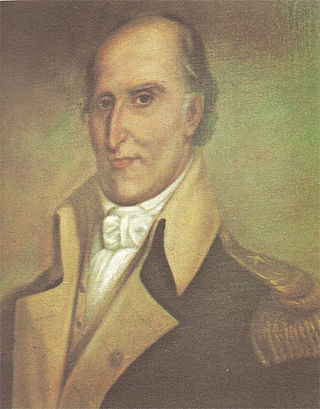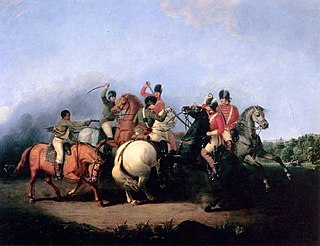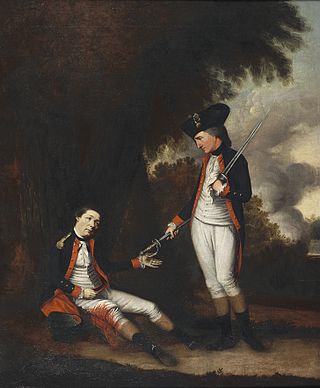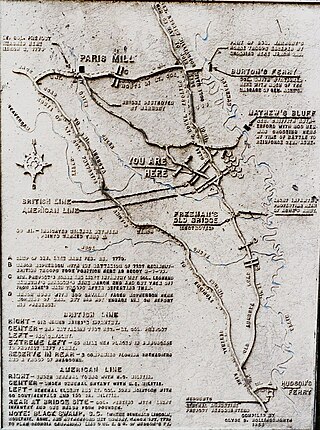
The siege of Charleston was a major engagement and major British victory in the American Revolutionary War, fought in the environs of Charles Town, the capital of South Carolina, between March 29 and May 12, 1780. The British, following the collapse of their northern strategy in late 1777 and their withdrawal from Philadelphia in 1778, shifted their focus to the North American Southern Colonies. After approximately six weeks of siege, Major General Benjamin Lincoln, commanding the Charleston garrison, surrendered his forces to the British. It was one of the worst American defeats of the war.

The siege of Savannah or the second battle of Savannah was an encounter of the American Revolutionary War (1775–1783) in 1779. The year before, the city of Savannah, Georgia, had been captured by a British expeditionary corps under Lieutenant-Colonel Archibald Campbell. The siege itself consisted of a joint Franco-American attempt to retake Savannah, from September 16 to October 18, 1779. On October 9 a major assault against the British siege works failed. During the attack, Polish nobleman Count Casimir Pulaski, leading the combined cavalry forces on the American side, was mortally wounded. With the failure of the joint attack, the siege was abandoned, and the British remained in control of Savannah until July 1782, near the end of the war.

The Battle of Kettle Creek was the first major victory for Patriots in the back country of Georgia during the American Revolutionary War that took place on February 14, 1779. It was fought in Wilkes County about eleven miles (18 km) from present-day Washington, Georgia. A militia force of Patriots decisively defeated and scattered a Loyalist militia force that was on its way to British-controlled Augusta.

The Battle of Moore's Creek Bridge was a minor conflict of the American Revolutionary War fought near Wilmington, North Carolina, on February 27, 1776. The victory of the North Carolina Provincial Congress' militia force over British governor Josiah Martin's and Tristan Worsley's reinforcements at Moore's was a turning point in the war; American independence was declared less than five months later.
The 1st South Carolina Regiment (Infantry) was authorized on June 6, 1775, at Charleston, South Carolina, for service with the South Carolina State Troops. On November 4, 1775, the unit was adopted into the Continental Army and on February 27, 1776 was assigned to the Southern Department. The regiment saw action at the Siege of Savannah and the Siege of Charleston. The British Army captured the regiment at Charleston on May 12, 1780, together with the rest of the Southern Department.
The 3rd South Carolina Regiment was an infantry regiment of the South Carolina Line during the American Revolutionary War. Raised in the western part of South Carolina, the regiment fought in the Siege of Savannah and the Siege of Charleston, surrendering to British forces in the latter.
The 4th South Carolina Regiment was raised on November 13, 1775, at Charleston, South Carolina, for service with the South Carolina Troops and later became part of Continental Army.

The southern theater of the American Revolutionary War was the central theater of military operations in the second half of the American Revolutionary War, 1778–1781. It encompassed engagements primarily in Virginia, Georgia, North Carolina, and South Carolina. Tactics consisted of both strategic battles and guerrilla warfare.
The Battle of Thomas Creek, also known as the Thomas Creek Massacre, was an ambush of a small detachment of mounted Georgia Militia by a mixed force of British soldiers, Loyalist militia, and British-allied Indians on May 17, 1777 near the mouth of Thomas Creek in northern East Florida. The encounter was the only major engagement in the second of three failed attempts by American forces to invade East Florida in the early years of the American Revolutionary War.

The Battle of Stono Ferry was an American Revolutionary War battle, fought on June 20, 1779, near Charleston, South Carolina. The rear guard from a British expedition retreating from an aborted attempt to take Charleston held off an assault by poorly trained militia forces under American General Benjamin Lincoln.

Augustine Prévost was a Genevan soldier best known for his service in the British Army during the Seven Years' War and the American War of Independence.

The Battle of Brier Creek was an American Revolutionary War battle fought on March 3, 1779, near the confluence of Brier Creek with the Savannah River in eastern Georgia. An American Patriot force consisting principally of militia from North Carolina and Georgia along with some Continental Army troops were defeated by British forces, suffering significant casualties. The rout damaged Patriot morale.

Griffith Rutherford was an American military officer in the Revolutionary War and the Cherokee-American Wars, a political leader in North Carolina, and an important figure in the early history of the Southwest Territory and the state of Tennessee.

The Battle of Sullivan's Island or the Battle of Fort Sullivan was fought on June 28, 1776, during the American Revolutionary War. It took place near Charleston, South Carolina, during the first British attempt to capture the city from American forces. It is also sometimes referred to as the first siege of Charleston, owing to a more successful British siege in 1780.

The Capture of Savannah was a battle of the American Revolutionary War fought on December 29, 1778. It pitted an American garrison of Continental Army and militia units against a British invasion force commanded by Lieutenant-Colonel Archibald Campbell. The capture of the city led to an extended occupation and was the opening move in the British southern strategy to regain control of the rebellious Southern Colonies by appealing to the relatively strong Loyalist sentiment there.
The Battle of Hanging Rock took place during the American Revolutionary War between the American Patriots and the British. It was part of a campaign by militia General Thomas Sumter to harass or destroy British outposts in the South Carolina back-country that had been established after the fall of Charleston in May 1780.
The history of Beaufort, South Carolina, is one of the most comprehensive and diverse of any community of its size in the United States.
The Province of Georgia was a significant battleground in the American Revolution. Its population was at first divided about exactly how to respond to revolutionary activities and heightened tensions in other provinces. Georgia was the only colony not present in the First Continental Congress in 1774. When violence broke out in 1775, radical Patriots took control of the provincial government, and drove many Loyalists out of the province. Georgia subsequently took part to the Second Continental Congress with the other colonies. In 1776 and 1778, Georgia served as the staging ground for several important raids into British-controlled Florida. The British army captured Savannah in 1778, and the American and French forces failed to recapture the city during the Siege of Savannah in 1779. Georgia remained under British control until their evacuation from Savannah in 1782.

Andrew Deveaux was an American Loyalist from South Carolina who is most famous for his recapture of the Bahamas in 1783.
The King's Carolina Rangers (KCR) was a loyalist militia regiment active during the American War of Independence. The KCR was composed of nine infantry companies, of which one was converted into a troop of dragoons in 1782. The unit primarily saw action in the South Carolina and Georgia theatres of the conflict.















